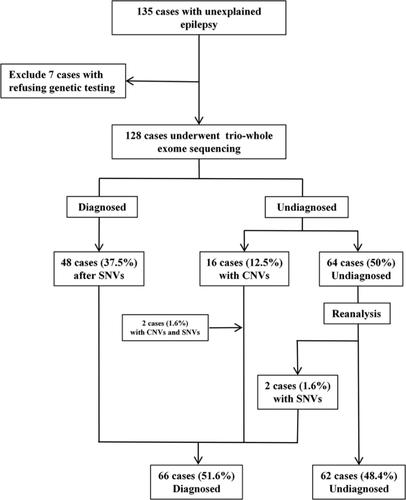当前位置:
X-MOL 学术
›
Clin. Genet.
›
论文详情
Our official English website, www.x-mol.net, welcomes your feedback! (Note: you will need to create a separate account there.)
Identification of genetic causes in children with unexplained epilepsy based on trio‐whole exome sequencing
Clinical Genetics ( IF 3.5 ) Pub Date : 2024-03-12 , DOI: 10.1111/cge.14519 Li Chengyan 1 , Xue Chupeng 1, 2 , Wang You 1 , Chen Yinhui 1 , Huang Binglong 1 , Ao Dang 1 , Liu Ling 1 , Tian Chuan 1
Clinical Genetics ( IF 3.5 ) Pub Date : 2024-03-12 , DOI: 10.1111/cge.14519 Li Chengyan 1 , Xue Chupeng 1, 2 , Wang You 1 , Chen Yinhui 1 , Huang Binglong 1 , Ao Dang 1 , Liu Ling 1 , Tian Chuan 1
Affiliation

|
Genotype and clinical phenotype analyses of 128 children were performed based on whole exome sequencing (WES), providing a reference for the provision of genetic counseling and the precise diagnosis and treatment of epilepsy. A total of 128 children with unexplained epilepsy were included in this study, and all their clinical data were analyzed. The children's treatments, epilepsy control, and neurodevelopmental levels were regularly followed up every 3 months. The genetic diagnostic yield of the 128 children with epilepsy is 50.8%, with an SNV diagnostic yield of 39.8% and a CNV diagnostic yield of 12.5%. Among the 128 children with epilepsy, 57.0% had onset of epilepsy in infancy, 25.8% have more than two clinical seizure forms, 62.5% require two or more anti‐epileptic drug treatments, and 72.7% of the children have varying degrees of psychomotor development retardation. There are significant differences between ages of onset, neurodevelopmental levels and the presence of drug resistance in the genetic diagnostic yield (all p < 0.05). The 52 pathogenic/likely pathogenic SNVs involve 31 genes, with genes encoding ion channels having the largest number of mutations (30.8%). There were 16 cases of pathogenic/possibly pathogenic CNVs, among which the main proportions of CNVs were located in chromosome 15 and chromosome 16. Trio‐WES is an essential tool for the genetic diagnosis of unexplained epilepsy, with a genetic diagnostic yield of up to 50.8%. Early genetic testing can provide an initiate appropriate therapies and accurate molecular diagnosis.
中文翻译:

基于三重全外显子组测序鉴定儿童不明原因癫痫的遗传原因
基于全外显子组测序(WES)对128例儿童进行基因型和临床表型分析,为癫痫的遗传咨询和精准诊治提供参考。本研究共纳入128例不明原因癫痫儿童,并对他们的所有临床数据进行分析。每三个月定期对儿童的治疗、癫痫控制和神经发育水平进行随访。128例癫痫患儿的基因诊断率为50.8%,其中SNV诊断率为39.8%,CNV诊断率为12.5%。128例癫痫儿童中,57.0%在婴儿期发病,25.8%有两种以上临床发作形式,62.5%需要两种或两种以上抗癫痫药物治疗,72.7%儿童存在不同程度的精神运动发育迟缓。发病年龄、神经发育水平和耐药性的存在之间的基因诊断率存在显着差异(所有p < 0.05)。52个致病/疑似致病SNV涉及31个基因,其中编码离子通道的基因突变数量最多(30.8%)。共有16例致病/可能致病的CNV,其中CNV的主要比例位于15号和16号染色体。Trio-WES是不明原因癫痫遗传诊断的必备工具,遗传诊断率高达50.8%。早期基因检测可以提供适当的治疗和准确的分子诊断。
更新日期:2024-03-12
中文翻译:

基于三重全外显子组测序鉴定儿童不明原因癫痫的遗传原因
基于全外显子组测序(WES)对128例儿童进行基因型和临床表型分析,为癫痫的遗传咨询和精准诊治提供参考。本研究共纳入128例不明原因癫痫儿童,并对他们的所有临床数据进行分析。每三个月定期对儿童的治疗、癫痫控制和神经发育水平进行随访。128例癫痫患儿的基因诊断率为50.8%,其中SNV诊断率为39.8%,CNV诊断率为12.5%。128例癫痫儿童中,57.0%在婴儿期发病,25.8%有两种以上临床发作形式,62.5%需要两种或两种以上抗癫痫药物治疗,72.7%儿童存在不同程度的精神运动发育迟缓。发病年龄、神经发育水平和耐药性的存在之间的基因诊断率存在显着差异(所有



























 京公网安备 11010802027423号
京公网安备 11010802027423号